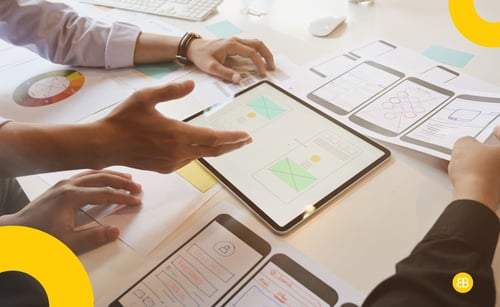Table of Contents
There’s a moment every founder hits.
It happens after the rush of the idea, after the scribbled notes on the back of a napkin, after the name is locked in and the domain is bought.
And then comes the question:
“How do I turn this into something real—without spending $50,000 and 6 months building an MVP?”
For many founders, especially those without a technical background, that’s where the momentum stalls. You know your idea has legs. You can picture people using it. You can almost hear the investors saying yes.
But the next step feels... big. Risky. Expensive.
Here’s the good news:
-
You don’t need a full product to get funding.
-
You don’t need code to prove your concept works.
-
You don’t even need a technical co-founder (yet).
What you need is a prototype.
A well-crafted, investor-ready prototype can be the single most powerful asset you create in the early stages of your startup. It helps you raise money, attract partners, test your thinking, and build momentum.
This guide will walk you through:
-
Why prototypes matter more than business plans
-
What makes a prototype truly “investor-ready”
-
How to build one (even if you're not technical)
-
And how to use it to fund, validate, and grow your vision
Let’s make your idea real.
1. Why Prototypes Matter More Than Business Plans
It’s tempting to think that a detailed business plan is the key to unlocking investor interest. After all, it’s thorough, strategic, and filled with projections.
But in today’s startup world, the most convincing thing you can bring to the table isn’t a 20-page document — it’s a prototype.
Because here’s the truth:
Investors don’t fund ideas — they fund execution.
A prototype shows that you’ve moved beyond “thinking” and into “building.” It turns your concept into something tangible — something people can see, click through, and experience.
What a Prototype Communicates:
-
✅ That you’re serious
-
✅ That you know your user
-
✅ That you’re solving a real problem
A prototype doesn’t need to be perfect. It just needs to be real enough to prove you're already solving problems — and you've got the screens to prove it.
A prototype doesn’t just validate your product — it validates you as a founder.

2. What Does “Investor-Ready” Actually Mean?
“Investor-ready” gets thrown around a lot in startup circles — but what does it actually mean?
Some founders think it means having a beautifully animated product demo or a pitch deck fit for a Series A.
But at the early stage? Investor-ready doesn’t mean perfection. It means clarity.
It means you've thought deeply about:
-
The problem you're solving
-
Who you're solving it for
-
How your solution works in the real world
A truly investor-ready prototype:
✅ Shows the problem-to-solution journey
✅ Communicates core product value
✅ Shows how users engage with it
✅ Suggests how it makes money
✅ Demonstrates that you’re a builder
Investors aren’t just investing in your product — they’re investing in how you think.
Internal vs. External Prototypes:
-
Internal: for you and your team — helps refine product direction.
-
External: for others — tells a compelling, visual story for investors.
An investor-ready prototype belongs in the second category.

3. When Should You Build a Prototype?
Many founders wait too long.
They think they need:
-
A dev team
-
A massive strategy deck
-
Pre-committed capital
But the truth is:
The prototype should come before development, before pitching, and before you spend big.
Ideal Timing:
Build a prototype after validating your idea — once you've had real conversations with users, spotted a problem, and confirmed demand. That’s when your vision is clear enough to map it.
If you're pitching without a prototype, you're asking investors to imagine.
If you're pitching with a prototype, you're showing them.
Depending on your funding strategy:
| Funding Path | What They Want to See |
|---|---|
| Angel Investors | Momentum and execution |
| Seed Rounds | Signals of product-market fit |
| Crowdfunding Campaigns | Visual storytelling and belief |
Don’t wait until it's perfect. Build it while it’s raw but validated.

4. What Kind of Prototype Do You Actually Need?
One of the first questions founders ask is:
“How polished does it need to be?”
The answer: Just polished enough to tell the story.
Types of Prototypes
📝 Low-Fidelity Prototype
-
Sketches, wireframes, or simple flows — no design, no interactivity.
-
Best for: Early validation, mapping journeys, internal use.
🧩 Mid-Fidelity Prototype
-
Clickable wireframes/mockups — simple but interactive.
-
Best for: Investors, accelerators, early user feedback.
🎨 High-Fidelity Prototype
-
Fully designed screens with branding, transitions, and animations.
-
Best for: Crowdfunding, vision-led fundraising, pre-sales.
How to Choose:
Ask yourself:
-
Who’s viewing it? (Tech-savvy investor or general backer?)
-
What do they need to feel?
-
How validated is the idea?
✅ For clarity-driven conversations: go mid-fidelity.
✅ For emotion-driven buy-in: go high-fidelity.
5. Crowdfunding? You Still Need a Prototype
Crowdfunding might look like slick videos and taglines, but at its core, it’s about belief — and belief is built on what people can see.
Why a Prototype Changes Everything:
-
✅ Shows you’ve already started building
-
✅ Helps people emotionally engage
-
✅ Reduces fear of backing something vague
What the best campaigns lead with:
-
🎯 A hero image in action
-
🎬 A 60–90 second walkthrough video
-
💬 A crisp explanation of why it matters
You don’t need every screen. Just the core journey — the one that makes people say, “Ah, I get it.”
Even for crowdfunding: build the prototype first.
6. Why a Prototype Helps You Raise Faster (and Smarter)
When raising, clarity is your currency. And prototypes buy clarity faster than anything else.
Without vs. With a Prototype
| Without a Prototype | With a Prototype | |
| Investor View | Abstract concept | Tangible, clickable walkthrough |
| Understanding | Needs imagination | Instantly grasped |
| Risk Perception | High | Reduced |
A prototype doesn’t just help your pitch. It anchors it.
It makes your deck stronger, your narrative tighter, and your confidence clearer.
Investors aren’t betting on your idea — they’re betting on your thinking.
7. Inside the Investor Mind: What They’re Really Looking For
Early-stage investors aren’t looking for flash. They’re looking for founder fit.
Unspoken Investor Questions:
-
“Does this founder understand the real problem?”
-
“Is this solving something people actually want?”
-
“Can they move fast and stay focused?”
-
“Are they resilient?”
Your prototype quietly answers all of these — without a single pitch slide.
🔍 What Investors Want to See:
| Investor Priority | What Your Prototype Should Show |
| 🎯 Real, urgent problem | Screens mirror a lived user pain |
| ✅ Believable solution | Clear transformation journey |
| 🚦 Signs of product-market fit | UX based on real user insight |
| 🧠 Founder clarity | Logical flow, no fluff |
Even if you don’t have traction — this builds belief.

8. What Makes a Prototype Truly “Investor-Ready”?
Not every prototype is built for pitching.
Some are messy drafts. Others are beautiful but confusing. A few are over-engineered with no clear story.
To be investor-ready, your prototype needs to be clear, logical, and narrative-driven.
The 5 Elements of an Investor-Ready Prototype
| ✔️ Trait | Why It Matters |
|---|---|
| Problem-to-Solution Alignment | Screens clearly walk from pain → relief without explanation |
| Logical User Flow | Every tap, swipe, or click makes sense and leads toward value |
| Visible Value Exchange | It’s obvious how users benefit and how the business makes money |
| Professional (not overbuilt) | Looks and feels real — doesn’t need bells or whistles |
| Pitch-Ready Narrative Support | Each screen reinforces your product story and vision |
When your prototype ticks these boxes, it becomes more than design — it becomes evidence.
9. How to Build a Prototype (Even If You’re Not a Designer or Developer)
If you’re thinking, “This all sounds great, but I’m not technical…” — you’re not alone.
Most early-stage founders aren’t designers or developers. And the good news?
You don’t need to be.
With today’s tools, building a prototype is about clarity of thought, not technical skill. You can bring your vision to life using no-code platforms and a simple framework.
Step-by-Step: Build Your Prototype Without Code
| Step | What to Do | Tools or Notes |
| 1️⃣ | Define your value proposition | What’s the core promise of your product? |
| 2️⃣ | Clarify your user and use case | Who’s it for? What’s their core problem? |
| 3️⃣ | Map the user journey | Sketch the flow from Problem → Outcome |
| 4️⃣ | Sketch wireframes | Balsamiq, Whimsical, pen & paper |
| 5️⃣ | Design high-fidelity screens | Figma, Adobe XD |
| 6️⃣ | Make it clickable | Figma prototypes, ProtoPie |
| 7️⃣ | Test with 3–5 real people | Watch them click through, note confusion |
| 8️⃣ | Record a short Loom walkthrough | Narrate the story and value clearly |
You don’t need every feature. You don’t need 20 screens. You just need enough to tell the story and help people believe.
10. Design Matters, But Story Wins
Let’s bust a myth:
Your prototype doesn’t need to look like it was designed by Apple.
What matters more than visuals? Storytelling.
Investors don’t care if your buttons have drop shadows. They care if your product:
-
Solves a real problem
-
Makes sense on first click
-
Reflects thoughtful design thinking
🎯 Focus on These Instead of Pixel-Perfect Design:
-
Clear navigation
-
Logical, simple flow
-
Concise content on each screen
-
Emotional payoff (“aha!” moments)
A polished prototype that confuses users = a waste of time.
A basic prototype with a clear, satisfying flow = belief-building gold.
Think of your prototype like a movie trailer. It doesn’t need the full production budget — it just needs to get people excited about the story.
💡 Analogy worth remembering:
“A Tesla prototype doesn’t need to fly. It just needs to roll.”
It should look and feel like a Tesla — not perfect, just believable.
11. Tools to Build It Without Code (or a Dev Team)
You can build a professional prototype without touching code.
✏️ Wireframing Tools
| Tool | Why Use It |
| Balsamiq | Hand-drawn style wireframes that focus on layout |
| Whimsical | Combines flowcharts, wireframes, and sticky notes |
🎨 Prototyping & UI Design Tools
| Tool | Why Use It |
| Figma | Industry standard. Easy to use. Massive templates |
| Adobe XD | Smooth interface. Great for interactivity |
| ProtoPie | Simulate gestures and device interactions |
✨ Optional Animation Tools
| Tool | Use Case |
| Framer | For interactive transitions & wow factor |
| Principle | For simulating native app experiences |
👥 User Testing Tools
| Tool | What It Helps With |
| Maze | Turns your prototype into a remote test |
| Useberry | Collects feedback directly on your designs |
🚀 Waitlist / Landing Page Tools
| Tool | What It Does |
| Carrd | Simple, responsive one-page websites |
| Typedream | Beautiful Notion-style sites with CMS power |
| Tally | Easy form builder for feedback or waitlists |
The tool doesn’t matter nearly as much as your story. Start with clarity. Build from there.
.jpg?length=500&name=12.%20What%20Founders%20Often%20Get%20Wrong%20(And%20How%20to%20Avoid%20It).jpg)
12. What Founders Often Get Wrong (And How to Avoid It)
Early mistakes aren’t fatal — but they can slow you down.
⚠️ Top 5 Prototype Mistakes to Avoid
| Mistake | What To Do Instead |
| ❌ Building the whole product | ✅ Focus only on the core user journey |
| ❌ Designing for perfection | ✅ Design for clarity and quick feedback loops |
| ❌ Confusing investor vs user prototype | ✅ Build for belief, not usability at this stage |
| ❌ Waiting too long to test | ✅ Share early. Adjust often. Iterate fast |
| ❌ Over-designing at the cost of flow | ✅ Prioritize a smooth, simple experience |
Your prototype isn’t the final product — it’s proof of direction.
13. How to Present Your Prototype Like a Pro
You’ve built your prototype. Now comes the moment of truth: sharing it.
Whether you’re walking through it live, sending it via email, or recording a demo video — how you present your prototype is just as important as what it contains.
🎬 The Investor-Ready Demo Formula
-
Start with the user’s problem
“Meet Priya, a small business owner who spends 4 hours a week managing invoices manually. Our app changes that.” -
Walk through the core flow
Focus only on the key journey where your product delivers value. -
Narrate like a story
Use emotional and functional language:-
“This is where the user feels the win...”
-
“Here’s how the revenue model fits into this flow...”
-
-
Close with forward momentum
“This is what we’ve built so far — and here’s where we’re headed next.”
📦 Package It for Sharing
-
✅ A clickable prototype link (Figma or ProtoPie)
-
✅ A 2–3 minute Loom walkthrough
-
✅ A one-pager summarising problem, user, solution, and monetisation
Don’t give a tour. Tell a transformation story.

14. Real Startups Who Got Funded with Just a Prototype
You don’t need a working product to raise money — you just need proof.
Here are three real examples from EB Pearls where the prototype was the pitch:
🏥 Case Study #1: Healthcare Roster Management App
-
Founder Type: Non-technical nurse administrator
-
Prototype: Figma screens showing roster creation, shift requests, and approvals
-
Highlights:
-
Shared a 90-second Loom with 3 investors
-
Raised $180K in pre-seed funding
-
Now live in pilot mode across 2 hospitals
-
🛍 Case Study #2: Fashion Rental Marketplace
-
Founder Type: First-time eCommerce founder
-
Prototype: High-fidelity UI with user onboarding, browsing, and checkout flow
-
Highlights:
-
Used prototype to pre-sell the concept via waitlist
-
Collected over 1,500 signups
-
Secured $250K in angel investment
-
💸 Case Study #3: SME Loan Pre-Approval Tool
-
Founder Type: Former banker, no tech team
-
Prototype: Clickable Figma showing real-time credit decision flow
-
Highlights:
-
Paired prototype with live data mock
-
Presented to fintech accelerator
-
Won $100K funding + $50K worth of dev support
-
✅ Clear user problem
✅ A focused, functional prototype
✅ Strong narrative
✅ Zero code
Don’t wait until your product is finished to pitch it. Show what matters. Invite belief.
15. Beyond the Prototype: What Happens Next
Your prototype isn’t the end of the story. It’s the start of your strategy.
Here’s what smart founders do next:
🚀 1. Build Your Pitch Deck Around the Prototype
Use screenshots, flows, and monetisation touchpoints. Let the prototype anchor your story.
🔁 2. Start User Conversations (Before You Write Code)
-
Share it with 3–10 potential users
-
Observe reactions, bottlenecks, and “aha” moments
-
Use tools like Maze or simple 15-min calls
💸 3. Get Dev Estimates for Your MVP
-
Scope out costs using your prototype
-
Prioritise features
-
Break work into clear, fundable phases
🗣 4. Iterate Based on Real Feedback
-
Refine journey
-
Rework messaging
-
Clarify monetisation paths
-
Make low-cost changes now to avoid expensive rebuilds later
📣 5. Launch a Waitlist or Early Access Page
-
Tease your product
-
Start collecting emails
-
Create FOMO before you even launch
A strong prototype + a growing waitlist = irresistible early-stage traction.
16. Visionary Takeaway: Build Proof, Not Pressure
There’s a myth that keeps too many founders stuck:
“I need a finished product to raise money or make progress.”
You don’t.
What you need is proof — something real enough to show that your idea isn’t just viable, it’s inevitable.
An investor-ready prototype tells the world:
-
I’ve done the thinking
-
I understand my user
-
I’ve mapped the solution
-
I’m serious about building this
You don’t need funding to start. You don’t need a dev team to get belief. You just need to turn your vision into something people can see.
Because once they see it, they start to believe. And once they believe, they start saying yes.
Prototypes don’t just win funding. They build belief.
They help you pitch with confidence, plan with clarity, and build what actually matters.
👋 Ready to Pick Up Where You Left Off?
If this guide helped you see a clearer path forward, now’s the perfect time to take the next step.
Book your discovery call with us again — we’ll walk you through:
-
The right prototype approach for your goals
-
How to move forward without code
-
What investors or early adopters need to see
-
And what it would take to bring your idea to life
No pressure. Just clarity, strategy, and forward momentum.
Let’s bring your idea back to life — with confidence.

Akash, COO at EB Pearls, blends technical expertise with business acumen, driving the creation of successful products for clients.
Read more Articles by this Author